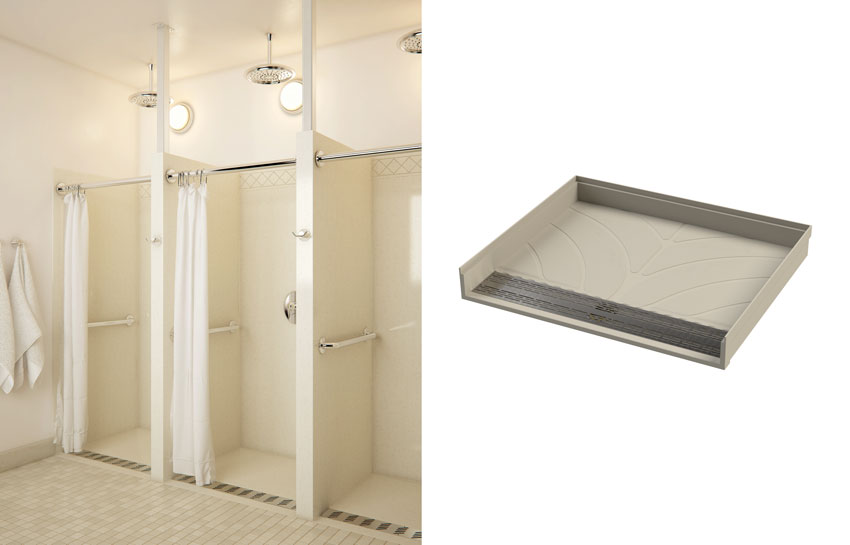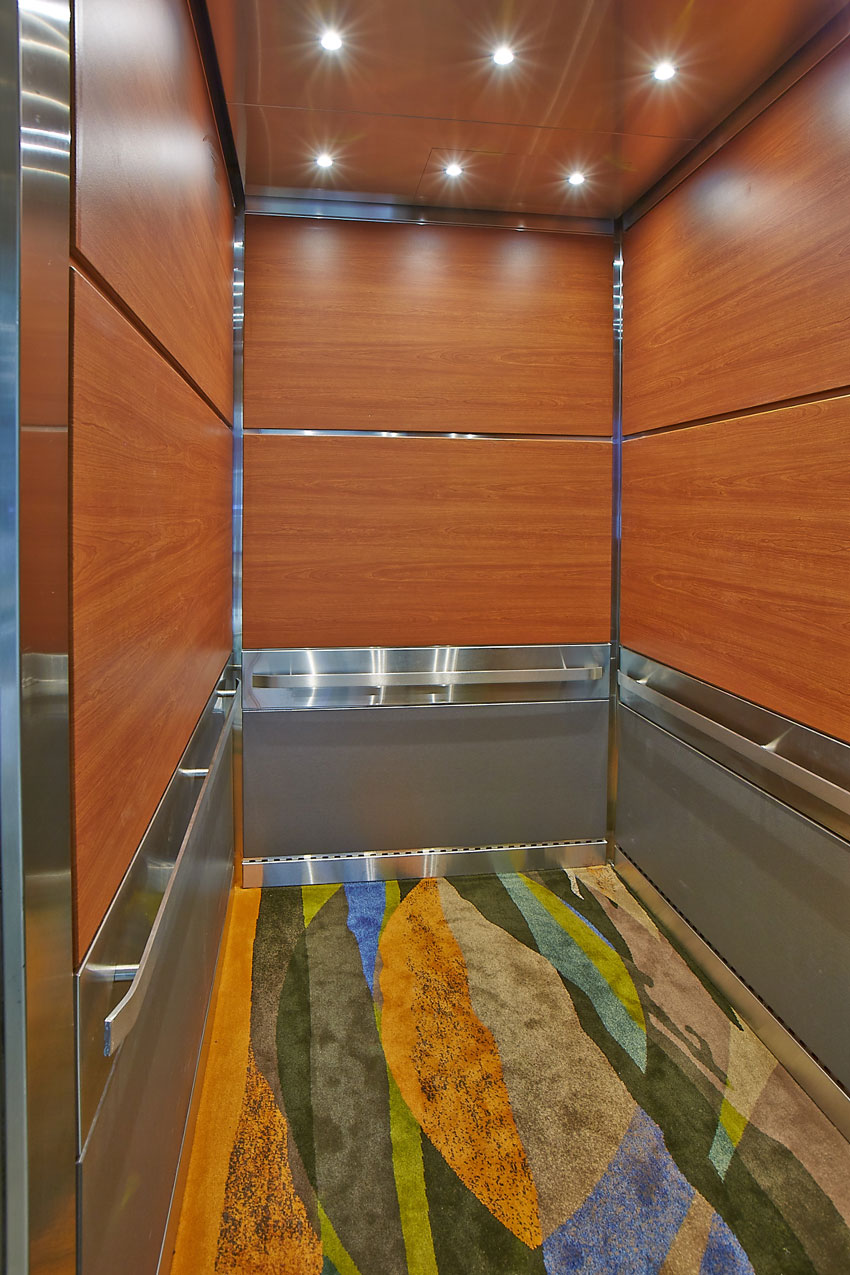Innovative Interiors
Accessible Showers
Restroom privacy is a particular concern when showers are included in the design. It is further the focus of design attention when accessibility is required. While most design professionals are familiar with the requirements of the International Building Code (IBC) and Americans with Disabilities Act (ADA) related to restrooms, the details of showers should not be overlooked since they are included in a wide range of accessible buildings.
The intent of accessible or “universal” design is to move toward inclusion and accommodation of people with physical disabilities to mainstream them wherever possible versus separating them from everyone else. Showers need to embrace this universal design too. No-threshold or curbless shower stalls are often used to achieve this, which allow ease of pedestrian access as well as wheelchair movement in the bathing space. A trench drain allows for better control of drain water flow and linear access, easing wheelchair maneuverability. Where a no-threshold or curbless shower may not be feasible, the installation of ADA-compliant ramps can be used.
With all of the above as a basis, many designers find that solid-surface panels are an excellent choice as a shower-enclosure material. Since solid surface is nonnutritive, it does not promote the growth of mold and mildew, and it resists bacterial growth. The inclusion of “active” antimicrobials like copper within the solid surface itself can reduce odor-causing bacteria. By contrast, with tile and grout, the porous grout is usually where the first black splotches of mold start growing. Where grout cracks or falls out, there is risk of water getting behind the tile, leading to tiles failing or moisture seeping into the gypsum board or other substrate. Cleaning and resealing tile means more work for maintenance staff and leaves room for error.
Solid-surface showers also mean quicker turnaround on installation over traditional tile. From start to cured finish, solid-surface showers can be ready to use in as little as four to five days compared to 12 days for traditional tile work. Slid surface receptors (floor pans) can be installed in as little as 1 hour versus three days for tile.
Solid-surface shower receptors can be poured and fabricated into many standard or custom shapes (L shapes, T shapes, neo angles, etc.) in a wide variety of sizes. The integral nonskid surface helps prevent slips and falls, and ADA edges and ramps can ease the transition from floor to receptor.

Photos courtesy of Inpro
Accessible showers made of solid-surface material provide clean, appealing conditions with receptor pans that can include trench drains for better access and water flow control.
A common misconception among designers and contractors is that shower receptors must always have the drain in the dead center of the receptor, but this is not true. Being able to put the drain hole in virtually any position—and slope the pan accordingly—is critical to easier field installation that accommodates unusual field conditions or plumbing locations. Drain locations can be set to match existing plumbing, and trench drains are also an option.
Modernized Elevator Cab Interiors
Among the most used interior spaces in a multistory building are the elevator cabs. The walls of these cabs have been discovered by many building owners as a means to communicate with visitors, tenants, and others about some aspect of the building use. In essence, the elevator cab can become a daily ambassador of the message or branding of the building. However, these cabs are subject to deterioration and damage precisely because of their heavy use. Therefore, the elevator cabs need to be upgraded regularly either to overcome a worn and unsightly appearance or simply upgrade the look to be consistent with the organization or other parts of the building. Further, leaving an old, damaged elevator cab out of a larger building renovation project can very well make the appearance look worse and leave an otherwise beautiful upgrade with a serious black eye.
The most cost-effective and innovative way to carry out such an elevator cab upgrade is to use preconfigured elevator cab renovation systems from a manufacturer that has a specialty line of products to address these needs. This system can include any or all of the following elements.
New panels: The elevator panels that line the walls are what primarily make up the appearance of the cab. These panels also typically take quite a beating from hospital beds to luggage carts, tenant move-ins and -outs, construction equipment, vandalism, and whatever else may come their way. Fortunately, the panels can be made of durable and rugged materials that can be made to look like any range of materials, from wood to metal to stone or custom choices.
New ceilings and lighting: Elevator ceilings come in many different styles and can be selected to suit an overall design concept. Lighting in elevator cabs can be chosen from among common lamping options, such as halogen, incandescent, fluorescent, or energy-efficient LED. Keep in mind that people tend to be more comfortable in a well-lit interior, so combining a brighter ceiling with increased lighting output can help people feel more relaxed inside, not to mention creating a newer and cleaner look. The energy efficiency of elevator cab lighting is notable since these lights typically stay lit 24 hours a day, seven days a week, meaning they are running for 8,760 hours a year. Further, selecting energy-efficient LED lighting means the lamps have a much longer service life, notably reducing maintenance costs for replacements.
New handrails: Handrails in elevators get attention for ADA or accessibility code requirements, but they also provide stability for users (i.e., something to grasp) while the elevator stops and starts. This is particularly true for elderly, disabled, or injured people who need help to reduce the risk of a fall. Beyond the people aspect of handrails, they provide a means for a complete look to the cab and can act as a wall guard too. By providing a standoff surface from the wall of the cab, they can reduce the chance of equipment or furniture striking the wall panels. As part of a total system for elevator cabs, handrails come in different shapes, sizes, and finishes.
Paying attention to both the appearance and durability of elevator cabs can be beneficial in terms of creating successful, innovative interiors.

Photo courtesy of Inpro
Renovated elevator cabs complete the interior design of a building, offer opportunities to make a better first impression, and can include durable, protective materials.
Conclusion
Supporting the health and wellness of building occupants can be directly addressed through current interior design trends. Biophilic design can be incorporated in many creative ways. Reconfigurable spaces can be achieved through the use of acoustically superior operable glass walls. Durable, thermally modified wood can provide the look of reclaimed wood or barn wood with more predictable results. Restrooms can be designed to incorporate hygienic, touchless design and privacy. Elevator cab renovation can complete an overall design and improve durability. Overall, innovations like these can be used by design professionals on all types of buildings to keep up with both changing trends and owner needs.
Notice

www.bradleycorp.com/verge-soap-and-faucet

www.inpro.com

www.nanawall.com

www.thermoryusa.com









